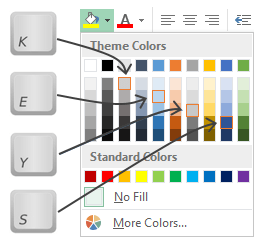

There are the changing fonts and sizes of text, setting background colors and patterns, paint border colors and select the type of their lines, etc. The formatting opens up wide possibilities for data exposure. The helpful advice! Format the data in the last place: so you will save your working time. Pasting cells in Excel allows you to select a row or column by color.Īs you can see in the «Format Cells» window there are multiplicity of tools, that expand the possibilities of formatting data. To confirm the change of the format of the cells, click OK.

To change the color of the selected cell in Excel, click the «Fill» tab and click on «Black». At present go to the «Font» tab and in the text color field select «Yellow». Select the headings of the original table A1:D1. To confirm the border formatting settings, click OK.Īlso we can make a colors text. Then go back to the «All» section and click on the «Outline» button. If necessary, set the color for the borders of the table below. Change system preferences for keyboard shortcuts with the mouse 1. To use these shortcuts, you may have to change your Mac keyboard settings to change the Show Desktop shortcut for the key. This topic flags such shortcuts with an asterisk ( ).
Change cell color in excel mac os shortcut windows#
Now in the line type section, select the thickest line (second from the bottom in the right column). Some Windows keyboard shortcuts conflict with the corresponding default Mac OS keyboard shortcuts. In the «Presets» toolbar of this tab, click the «Inside» button. The multifunction dialog box «Format Cells» will appear.įirst go to the «Border» tab. Press the hotkey combination CTRL + 1 or CTRL + SHIFT + F. To delete a character to the right, use Delete in Windows, and function + delete on a Mac.įinally, to add a new line in a cell, use Alt + Enter in Windows, and Control + Option + Return on a Mac.Select again the entire table A1:D4.

To delete a character to the left, use backspace in Windows, and the Delete key on a mac. To move through text one character at a time, use only the right and left arrow keys.īy adding shift, you can precisely select one or more characters. To step through a cell word by word, use the control key with the right or left arrow keys.Īs before, you can combine this with the shift key to select individual words and references. You can combine these shortcuts with shift to select everything in the cell from either direction:

To move to the end again, use the End key in Windows, and function + right arrow on a mac. To move the cursor to the beginning of the cell, use the Home key on Windows, and function + left arrow on a mac. When first enter edit mode, you're cursor will sit just after the last character in the cell. You can also use the Undo command when editing a cell. However, pressing F2 (or Control U on a Mac) takes me directly to the formula bar.įor the rest of this video, I'll leave that setting, since the shortcuts we're going to look at will be easier to see in the formula bar.Īt any time you've started editing a cell, you can cancel the edit by clicking the Escape key. With this change, I can no longer double-click to edit a cell. On a Mac, go to preferences by using Command + comma, then click "Edit", and uncheck checkbox called "Double clicking allows editing directly in a cell" Then go to Advanced, and uncheck the checkbox labeled "Allow editing directly in cells" In Windows, use Alt F to access the File menu, then T to access options. If you want to always edit cells in the formula bar, even when you use a keyboard shortcut to edit a cell, you'll need to change a setting. You can also double-click a cell to edit. With Excel's default settings, this will put your cursor directly in the cell, ready to edit. In this video, we'll look at shortcuts for editing cells.įirst, the keyboard shortcut for editing a cell is F2 on Windows, and Control + U on a Mac.


 0 kommentar(er)
0 kommentar(er)
